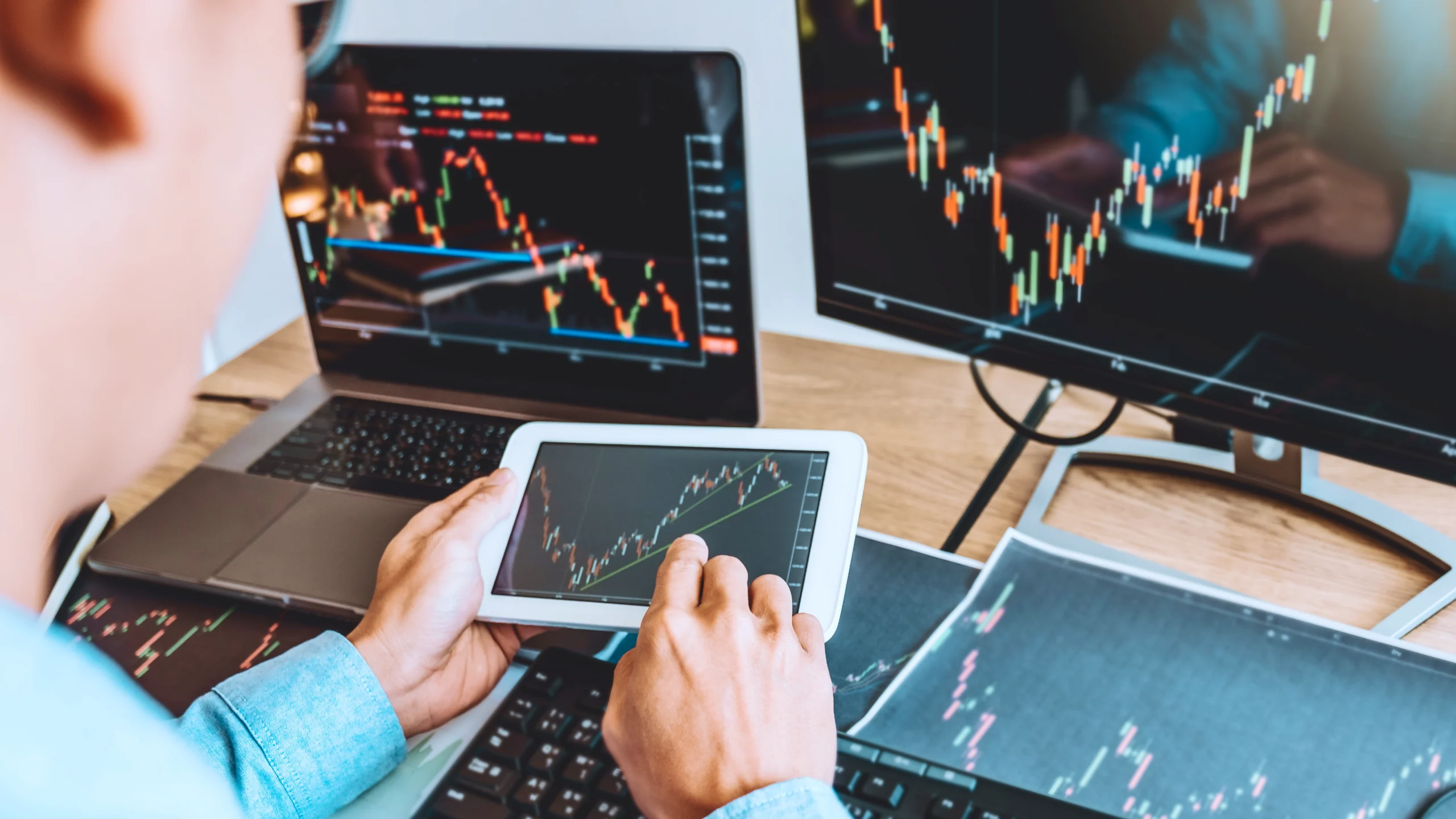
Baixe o App
-
- Plataformas de Trading
- PU Prime App
- MetaTrader 5
- MetaTrader 4
- PU Copy Trading
- Trader Web
- PU Social
-
- Condições de Trading
- Tipos de Conta
- Spreads, Custos & Swaps
- Depósitos & Retiradas
- Taxas & Encargos
- Horários de Trading

Baixe o App
Content:
Contract For Differences (CFDs) are financial contracts that enable traders to earn from the price fluctuations of a particular asset without actually owning the asset. CFDs state within the terms of the agreement between the broker and traders the asset being traded, the contract size and the price that is being agreed upon. This way, CFD traders only cash-settle the price difference in the opening and closing prices of the contract.
Originally introduced in the 1990s by Smith New Court, a brokerage in London, CFDs were primarily used by institutional investors to efficiently hedge their equity shares. However, due to their low margin requirements, flexibility, and ability to speculate on a wide range of financial instruments, CFDs have gained popularity among retail traders.
Today, CFDs are most commonly used to trade forex, indices, and metals; although many people also trade CFDs in various asset classes including shares, bonds, ETFs, and more.
Learn more about CFD trading, and how it works below.
There are several advantages offered by CFD trading platforms.
Firstly, trading CFDs allow traders to earn from both long and short positions. In addition to taking on a long position (or buying) when you think the price of an asset will rise in the future, you can choose to open a short CFD position (or selling) instead of deciding on trading a new asset if you think that the prices of the asset you are currently trading will fall.
While taking on a short position is possible in traditional exchanges, these usually incur shorting or borrowing costs, since the logic behind shorting an asset is selling the asset that you do not own – thus having to borrow (and incurring an interest on) said asset from a broker first. However, with CFDs, since there is no ownership of any underlying assets, it costs nothing to short an asset.
As CFD brokers only deal in the contracts to various assets, it’s easier for them to offer a wide range of assets and asset classes all in the same platform. As such, CFD traders can get access to a wide variety of financial instruments, such as forex, shares, commodities, indices or even bonds. The flexibility to trade allows CFD traders to easily diversify their portfolio, as well as look for opportunities in a wide range of markets.
Traders can also gain from using leverage provided by CFD trading platforms. Leverage allows them to open positions without paying for the full cost needed in the context of traditional trading. Using CFD brokers that provide leverage as a service, traders can open trades at a notional volume many times more than their capital.
To do this, traders will only need to pay a portion of capital known as margin to open a position and have its profits amplified depending on the leverage size of the trade asset.
While leverage does amplify profits, it is a double-edged sword. It is also important to note that both profits and losses of the trade are based on the full value of the position you are going for. It is highly advisable for one to use risk management tools such as stop-loss orders.
Another benefit offered by CFD providers will be that one would not need to pay the UK stamp duty when he or she buys or sells markets. This directly means lesser tax bills and hence, lower trading bills as well. This is definitely a gain for beginner CFD traders as it would not incur that much trading expenses.
However, as with most forms of profit gained on any assets, traders will still be required to pay capital gains taxes in places like the UK.
That said, laws change from time to time, and any tax requirements addressing for CFDs might be adjusted at any time, and traders are advised to pay close attention to these changes.

On the contrary, there are also risks which CFD traders should be aware of before engaging in this type of trading.
Leverage will cause any losses to be amplified. CFD traders can potentially lose more than their initial investment should they take on oversized positions or have a risky trading strategy.
This means that within a short period of time, traders can experience significant price swings which can be challenging to manage and can result in great losses.
Because forex CFD trading is an OTC (over-the-counter) product, there is no central exchange to regulate the trading of CFDs. This has led to the presence of unregulated scam brokers that prey on customers by offering exceptionally high spreads or just plain running away with customers’ funds.
That said, there are regulatory bodies around the world that look out for the best interest of CFD traders. These regulators will stipulate certain requirements of your broker, including ensuring a capital requirement and ensuring that client funds are segregated from the broker’s own accounts. Always trade with a regulated CFD broker to ensure that you are protected from predatory practices.
Due to the usage of leverage, CFD trading can be complicated compared to traditional trading as traders will need to understand how margin works. Hence, a very good understanding of financial markets – and how your positions will be affected by margin requirements would be important to trade well. A consequence of having leveraged positions is also the fact that some CFD products will incur a swap fee, also known as overnight interest. This additional cost of trading will also affect profitability of positions.
It would be advisable for CFD traders to do more research so that one can accurately assess market conditions and make more informed decisions.
Check out some of PU Prime’s trading blogs and daily financial news articles.
Learn Some Tips On Choosing The Right CFD Broker
In trading, “taking a long position” or simply “going long” refers to purchasing a specific asset with the expectation that its value will rise. On the contrary, “taking a short position” or “going short” refers to selling an asset with the belief that its value will decrease.
If you decide to “go long” on an asset with the expectation that its value will rise, and the price does indeed increase, you can choose to sell it and earn a profit. On the other hand, if you decide to take a short position on an asset, and the price does fall, you can choose to buy the asset back and still earn a profit as well. What’s important to note is that opening a short position does not require someone to first own the contract or asset first. Instead, going short is similar to a scenario where one “borrows” an asset from their broker to sell first; and then buying back said asset to return to the broker when closing the position at a later date.
The total cost incurred in CFD trading can vary depending on several factors, such as the CFD brokerage platform you decide on using, the size of your trades, and the underlying assets you trade. Typically, CFD trading involves spread, swap fees and other forms of trading charges.
Spreads refer to the difference between the buy and sell price of an asset, and they are typically charged on every trade you make. Swap fees refer to the financing charges charged by CFD brokers for borrowing funds to keep trade positions open if one decides to do so overnight. These fees are mostly passed down from a broker’s liquidity providers, and can be positive or negative depending on prevailing interest rates for each currency.

Leveraging is a way of increasing one’s potential returns by amplifying the size of their own trades through borrowing capital from the broker. When using leverage in CFD trading, only a small amount of capital is required for traders to enter a trade, and the broker will provide the remaining amount required. The traders will then be able to trade financial instruments on a larger scale than what they could trade originally with their own capital.
According to the definition of leverage, the “margin” is the required amount of capital that a trader needs to put up as collateral in order to trade with leverage. For example, if traders want to open a position with a notional value of $50,000 with only $5000 of their own capital, they can use a broker offering 10 times leverage.
If the asset price goes up, the trader would make a profit based on the notional value of the trade, which is $50,000 in this case; meaning that if the asset rises by 10% to $55,000 the trader will make $5000, or a 100% return on their capital.
Conversely if the asset price drops by 10% to $45,000, the trader will lose $5000, meaning 100% of their capital. Therefore, it is essential for traders to have a good risk management strategy in place to mitigate the potential for significant losses before engaging in this type of trading.
CFD trading can be a profitable approach to participate in the financial markets, but it is vital for beginners to gain knowledge about the market’s details and formulate a trading strategy.
One popular trading strategy used in CFD trading is momentum trading, it involves taking advantage of the price trends of an asset in order to make a profit. The idea behind this strategy is that assets that have been performing well in the recent past are likely to continue to do so in the near future, while assets that have been performing poorly are likely to continue to do so.
In CFD trading, momentum traders typically use technical analysis to identify assets that are exhibiting a strong trend, and then open a position in the direction of that trend. The aim is to buy an asset that is on an upward trend, and short an asset that is on a downward trend, in order to make a profit. To identify momentum, CFD traders use technical indicators like moving averages, relative strength index (RSI), and stochastic oscillators to determine when an asset is overbought or oversold, and when a trend may be about to reverse.
It is important to note that momentum trading can be a high-risk strategy, as it relies heavily on market trends, which can change quickly and unpredictably. Traders must be vigilant and closely monitor their positions to avoid significant losses.
Range trading is a CFD trading strategy that involves identifying an upper and lower limit for the price range of a particular asset, this can be done using technical analysis tools such as support and resistance levels, trend lines, and moving averages. Once the range has been established, CFD traders can profit from the price movements within this range by buying at the lower limit and selling at the upper limit.
One of the key advantages of range trading is that it is a relatively lower-risk strategy as traders are buying and selling within a well-defined price range. However, range trading requires close monitoring of the price movements to identify when to enter and exit trades. If the price breaks out of the established range, traders may need to adjust their strategy or exit their positions to avoid significant losses.
Overall, range trading is a popular strategy for CFD traders who prefer a more stable and predictable market environment, and who are comfortable with taking small profits over a longer period of time.

Another CFD trading strategy used typically is news trading strategy which involves using news events to make trading decisions. This strategy is based on the idea that major news events such as economic data releases, political announcements, and corporate earnings reports can have a significant impact on the financial markets.
CFD traders who use news trading strategy typically monitor news feeds and economic calendars to identify upcoming events that could affect the markets. When a significant news event occurs, traders may open positions based on their interpretation of the news and its potential impact on the market.
On the other hand, traders using the news trading strategy must be aware that it can be risky because of high market volatility in the immediate aftermath of a major news event. They must be prepared to manage their risk carefully, using stop-loss orders and other risk management techniques to limit their potential losses.
Another trading strategy used commonly in CFD trading is scalping that involves opening and closing positions quickly, often within minutes or even seconds, in order to make small profits on each trade. The objective of this trading strategy is to accumulate many small profits from frequent over a period of time.
As part of the scalping strategy, traders would look for markets with tight bid-ask spreads and high liquidity, as these conditions make it easier to enter and exit trades quickly. Traders may also use technical analysis tools such as charts and indicators in the process to identify short-term price movements and trends.
However, this can be a high-risk, energy-consuming CFD trading strategy, as it requires traders to constantly monitor the markets closely and make quick decisions and react to changes in real-time.
CFD traders who use this strategy must be prepared to manage their risk carefully, using stop-loss orders and other risk management techniques to limit their potential losses. Additionally, some CFD brokers may have restrictions or rules around scalping, such as limiting the number of lots that traders can trade in one instance or requiring minimum holding periods, so traders should be aware of these rules before using the scalping strategy in CFD trading.
Last but not least, breakout trading is a popular CFD trading strategy that involves identifying price levels where a security or market is poised to move sharply in one direction or another.
In breakout trading, CFD traders look out for key levels of support or resistance where a security or market has been trading within a range for an extended period. The trader then places a trade in the direction of the breakout, anticipating a significant move in that direction.
Nevertheless, this CFD trading strategy requires a disciplined approach and a keen understanding of technical analysis. Traders must be able to identify key levels of support and resistance, and have a clear understanding of when to enter and exit positions. As with any trading strategy, it is important to manage risk carefully and maintain a disciplined approach to trading.
Start CFD Trading With PU Prime Live/Demo Account
CFD (Contract For Differences) trading is a form of derivative trading where participants do not issue nor receive any underlying assets. Instead, the price difference of any such trading is cash-settled.
CFDs have advantages like lower transaction costs, access to a variety of markets, the ability to trade both long and short positions, and the use of leverage to boost potential profits.
This is a common query from traders who are curious about the possible drawbacks of CFD trading. The risks associated with CFD trading are similar to most other forms of derivative trading, including market volatility, leverage risk, counterparty risk, and liquidity risk.
When selecting a CFD trading platform, you can offer advice and points to keep in mind, such as regulation, trading platforms, fees and commissions, customer support, and educational resources.
You can find out more about PU Prime’s trading platforms, like PU Prime mobile trading app.
One of the most useful things new traders can do is to keep a trading journal. This allows for a more disciplined approach to trading, allowing traders to understand themselves better and formulate a strategy suited to their history and habits.

Trade forex, indices, Metais, and more at industry-low spreads and lightning-fast execution.
Registe-se para uma Conta PU Prime Real com o nosso processo sem complicações
Financie sem esforço a sua conta com uma vasta gama de canais e moedas aceites
Aceda a centenas de instrumentos em condições de negociação líderes de mercado
Please note the Website is intended for individuals residing in jurisdictions where accessing the Website is permitted by law.
Please note that PU Prime and its affiliated entities are neither established nor operating in your home jurisdiction.
By clicking the "Acknowledge" button, you confirm that you are entering this website solely based on your initiative and not as a result of any specific marketing outreach. You wish to obtain information from this website which is provided on reverse solicitation in accordance with the laws of your home jurisdiction.
Thank You for Your Acknowledgement!
Ten en cuenta que el sitio web está destinado a personas que residen en jurisdicciones donde el acceso al sitio web está permitido por la ley.
Ten en cuenta que PU Prime y sus entidades afiliadas no están establecidas ni operan en tu jurisdicción de origen.
Al hacer clic en el botón "Aceptar", confirmas que estás ingresando a este sitio web por tu propia iniciativa y no como resultado de ningún esfuerzo de marketing específico. Deseas obtener información de este sitio web que se proporciona mediante solicitud inversa de acuerdo con las leyes de tu jurisdicción de origen.
Thank You for Your Acknowledgement!